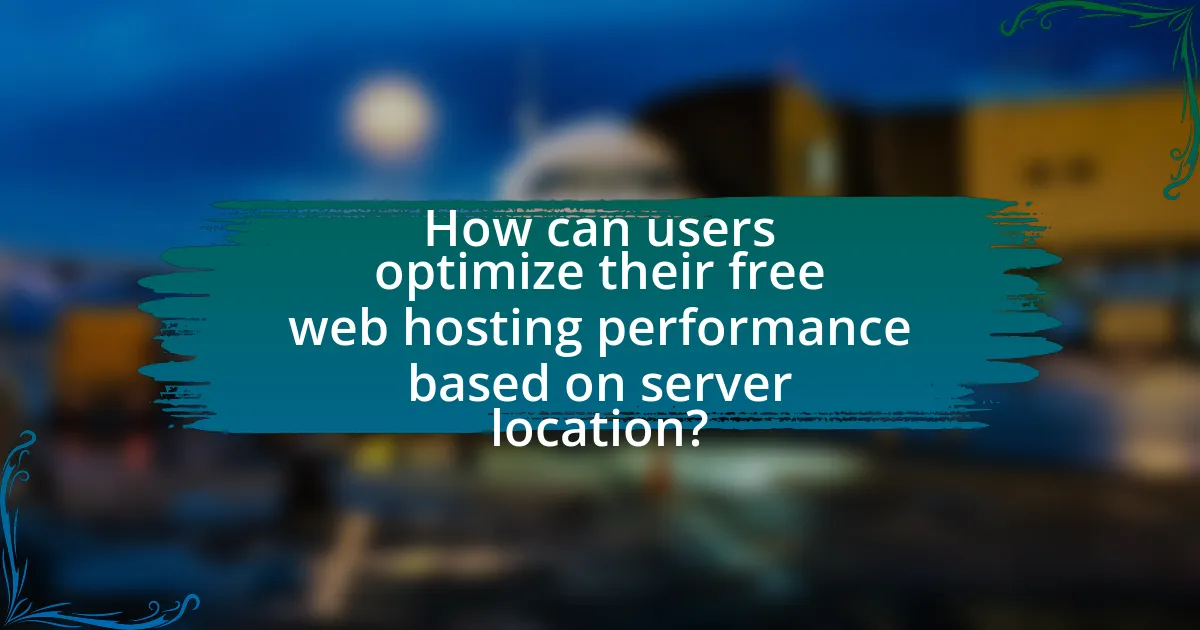The article examines the significant impact of server location on the performance of free web hosting services. It highlights how geographical proximity between servers and users affects latency, loading speed, and overall user experience, emphasizing that closer servers lead to faster data transmission and improved engagement. Key factors influencing performance include latency, bandwidth, and network infrastructure, while the article also discusses the advantages and limitations of local versus global servers. Additionally, it provides strategies for optimizing web hosting performance based on server location, including the use of Content Delivery Networks (CDNs) and considerations for legal compliance.

What is the Impact of Server Location on Free Web Hosting Performance?
Server location significantly impacts free web hosting performance by affecting latency, speed, and accessibility. When servers are geographically closer to users, data transmission occurs more quickly, resulting in lower latency and faster loading times. For instance, a study by Akamai Technologies found that a one-second delay in loading time can lead to a 7% reduction in conversions. Additionally, free web hosting services often utilize shared resources, which can exacerbate performance issues if the server is located far from the target audience. Therefore, the proximity of the server to the end user is crucial for optimizing performance in free web hosting scenarios.
How does server location influence website loading speed?
Server location significantly influences website loading speed due to the physical distance between the server and the user. When a server is located closer to the user, data packets travel shorter distances, resulting in reduced latency and faster loading times. For instance, a study by Akamai Technologies found that a one-second delay in loading time can lead to a 7% reduction in conversions, highlighting the importance of server proximity. Additionally, network infrastructure and routing efficiency can vary by region, further affecting speed; thus, selecting a server location that aligns with the target audience’s geographical distribution is crucial for optimal performance.
What factors contribute to loading speed variations based on server location?
Loading speed variations based on server location are primarily influenced by latency, bandwidth, and the physical distance between the server and the user. Latency refers to the time it takes for data to travel from the server to the user; greater distances increase this time. Bandwidth affects the amount of data that can be transmitted simultaneously; higher bandwidth allows for faster loading times. Additionally, network congestion and the quality of the internet infrastructure in the server’s location can further impact loading speeds. For instance, a study by Akamai Technologies found that a one-second delay in loading time can lead to a 7% reduction in conversions, highlighting the critical role of server location in web performance.
How does geographical distance affect latency in web hosting?
Geographical distance significantly affects latency in web hosting by increasing the time it takes for data to travel between the server and the user. As the physical distance between the server and the end user increases, the time required for data packets to traverse that distance also rises, leading to higher latency. For instance, data traveling from a server located in Europe to a user in North America will experience greater latency compared to data traveling within the same continent. Studies indicate that latency can increase by approximately 1 millisecond for every 200 kilometers of distance, highlighting the direct correlation between distance and response time in web hosting scenarios.
Why is server location important for user experience?
Server location is crucial for user experience because it directly affects website loading speed and latency. When servers are geographically closer to users, data travels shorter distances, resulting in faster response times. For instance, a study by Akamai found that a 100-millisecond delay in loading time can decrease conversion rates by 7%. Additionally, server location influences content delivery, as local servers can provide region-specific content more efficiently. Therefore, optimizing server placement enhances overall user satisfaction and engagement.
How does server location impact user engagement and retention?
Server location significantly impacts user engagement and retention by influencing website loading speed and accessibility. Faster loading times, which are often achieved when servers are geographically closer to users, lead to improved user experiences, resulting in higher engagement rates. Research indicates that a one-second delay in page load time can lead to a 7% reduction in conversions, highlighting the importance of server proximity. Additionally, users are more likely to return to websites that load quickly and perform reliably, thus enhancing retention. Studies show that 53% of mobile site visitors abandon sites that take longer than three seconds to load, further emphasizing the critical role of server location in maintaining user interest and loyalty.
What role does server location play in SEO rankings?
Server location significantly influences SEO rankings by affecting website loading speed and latency for users in different geographical areas. Search engines prioritize user experience, and a server located closer to the target audience typically results in faster load times, which can lead to lower bounce rates and higher engagement. According to a study by Google, a one-second delay in loading time can lead to a 20% decrease in traffic. Therefore, having a server in proximity to the primary user base can enhance site performance and positively impact search engine rankings.

What are the different types of server locations available for free web hosting?
Free web hosting typically offers server locations in various regions, including North America, Europe, Asia, and sometimes Australia. These locations are chosen to optimize performance based on user demographics and traffic patterns. For instance, a server located in North America may provide faster access for users in that region due to reduced latency. Additionally, some free hosting services may offer global content delivery networks (CDNs) that cache content in multiple locations, further enhancing performance for users worldwide.
What are the advantages of using local servers for web hosting?
Using local servers for web hosting offers several advantages, including improved speed, enhanced security, and better customer support. Local servers reduce latency, as data travels shorter distances, resulting in faster loading times for users. Additionally, hosting data locally minimizes exposure to international data regulations, thereby enhancing security and compliance with local laws. Furthermore, local hosting providers often offer more personalized customer support, as they are familiar with the specific needs and challenges of the local market. These factors collectively contribute to a more efficient and reliable web hosting experience.
How do local servers enhance performance for regional users?
Local servers enhance performance for regional users by reducing latency and improving data transfer speeds. When servers are geographically closer to users, the time it takes for data to travel between the server and the user decreases, resulting in faster loading times and a more responsive experience. Studies show that latency can be reduced by up to 50% when using local servers compared to distant ones, significantly benefiting applications that require real-time interactions, such as online gaming or video conferencing. Additionally, local servers can handle regional traffic more efficiently, leading to better bandwidth utilization and reduced congestion, which further enhances overall performance for users in that area.
What limitations do local servers have compared to global servers?
Local servers have limitations in scalability, performance, and accessibility compared to global servers. Local servers typically serve a smaller geographic area, which can lead to slower response times for users located far away, while global servers utilize multiple data centers worldwide to ensure faster access and reduced latency. Additionally, local servers may struggle to handle high traffic volumes effectively, as they often lack the robust infrastructure and resources that global servers possess, which are designed to manage large-scale demands. This difference in infrastructure is evidenced by the fact that global server networks can distribute loads across various locations, enhancing reliability and uptime, while local servers may experience outages or slowdowns during peak usage times.
What are the benefits of using global servers for web hosting?
Using global servers for web hosting enhances website performance, accessibility, and user experience. Global servers reduce latency by allowing data to be processed closer to the end user, which can lead to faster loading times. According to a study by Akamai, a 100-millisecond delay in website load time can decrease conversion rates by 7%. Additionally, global servers improve redundancy and reliability, as they can distribute traffic and handle failures more effectively. This geographical diversity also allows businesses to comply with local data regulations, enhancing legal compliance and trust with users.
How do global servers improve accessibility for international users?
Global servers improve accessibility for international users by reducing latency and enhancing load times. When servers are strategically located in various regions around the world, they can deliver content more quickly to users by minimizing the distance data must travel. For instance, a user in Europe accessing a website hosted on a server in Europe will experience faster loading times compared to accessing the same site from a server located in North America. Studies show that reducing latency by just 100 milliseconds can increase user engagement significantly, as faster response times lead to better user experiences and lower bounce rates. Therefore, the geographical distribution of servers directly correlates with improved accessibility for users across different international locations.
What challenges do global servers face in terms of performance?
Global servers face significant challenges in terms of performance primarily due to latency, bandwidth limitations, and data sovereignty issues. Latency arises from the physical distance between users and servers, leading to slower response times; for instance, a user in Asia accessing a server located in North America may experience delays of over 100 milliseconds. Bandwidth limitations can restrict the amount of data transmitted, affecting load times and user experience, especially during peak usage periods. Additionally, data sovereignty issues complicate compliance with local regulations, which can impact server performance and accessibility. These factors collectively hinder the efficiency and reliability of global server operations.

How can users optimize their free web hosting performance based on server location?
Users can optimize their free web hosting performance by selecting a server location that is geographically closer to their target audience. This proximity reduces latency, leading to faster loading times and improved user experience. For instance, studies show that a decrease in distance between the server and the user can reduce latency by approximately 20 milliseconds for every 100 miles. Additionally, users should consider using Content Delivery Networks (CDNs) that cache content at multiple locations, further enhancing access speed for users across different regions. By strategically choosing server locations and leveraging CDNs, users can significantly enhance the performance of their free web hosting services.
What strategies can be employed to choose the best server location?
To choose the best server location, evaluate factors such as target audience proximity, latency, legal compliance, and data center reliability. Proximity to the target audience minimizes latency, enhancing user experience; for instance, a server located closer to users in Europe will provide faster access than one in Asia. Legal compliance is crucial, as different regions have varying data protection laws, such as GDPR in Europe, which mandates strict data handling practices. Additionally, selecting a data center with a proven track record of uptime and reliability ensures consistent performance; for example, data centers with at least 99.9% uptime are generally preferred. These strategies collectively contribute to optimizing web hosting performance.
How can users assess the impact of server location on their specific needs?
Users can assess the impact of server location on their specific needs by evaluating latency, data transfer speeds, and compliance with local regulations. Latency, which refers to the time it takes for data to travel between the server and the user, is significantly affected by distance; for example, a server located closer to the user typically results in lower latency and faster response times. Data transfer speeds can also vary based on server location, as geographical proximity often leads to improved performance; studies show that users experience up to 50% faster loading times when accessing servers within the same region. Additionally, compliance with local regulations, such as data protection laws, can influence the choice of server location, as hosting data in specific jurisdictions may be required for legal compliance.
What tools are available to measure website performance based on server location?
Tools available to measure website performance based on server location include Pingdom, GTmetrix, and WebPageTest. Pingdom provides insights into load times and performance metrics from various global locations, allowing users to assess how server location affects speed. GTmetrix analyzes page speed and performance, offering location-based testing options to evaluate the impact of server proximity. WebPageTest allows users to run tests from multiple geographic locations, providing detailed performance data that highlights the influence of server location on website loading times. These tools are widely recognized for their accuracy and reliability in measuring website performance across different server locations.
What common troubleshooting tips can enhance performance related to server location?
To enhance performance related to server location, ensure that the server is geographically closer to the target audience. This proximity reduces latency, which is the time it takes for data to travel between the server and the user. Additionally, utilize Content Delivery Networks (CDNs) to cache content at various locations, further improving load times. Regularly monitor server performance metrics, such as response times and uptime, to identify and address any issues promptly. Implementing these strategies can significantly improve user experience and overall performance, as studies show that reducing latency by just 100 milliseconds can increase conversion rates by 7%.
How can users mitigate latency issues caused by server location?
Users can mitigate latency issues caused by server location by utilizing Content Delivery Networks (CDNs) to cache content closer to end-users. CDNs distribute copies of web content across multiple geographically dispersed servers, reducing the distance data must travel, which in turn decreases latency. Research indicates that using a CDN can improve load times by up to 50% for users located far from the original server. Additionally, users can select hosting providers with data centers strategically located near their target audience, further minimizing latency.
What best practices should be followed when selecting a free web hosting service based on server location?
When selecting a free web hosting service based on server location, prioritize choosing a server that is geographically close to your target audience. This proximity reduces latency, leading to faster load times and improved user experience. For instance, research indicates that a one-second delay in page load time can result in a 7% reduction in conversions, highlighting the importance of server location in performance. Additionally, consider the legal and regulatory implications of the server’s location, as data protection laws vary by country. For example, hosting in the European Union subjects your data to GDPR regulations, which may impact your operations.


